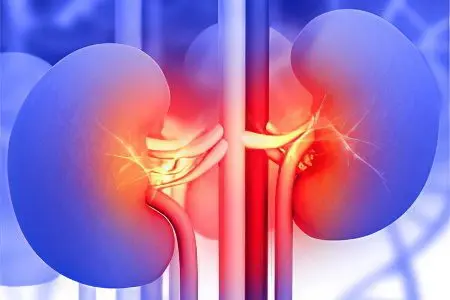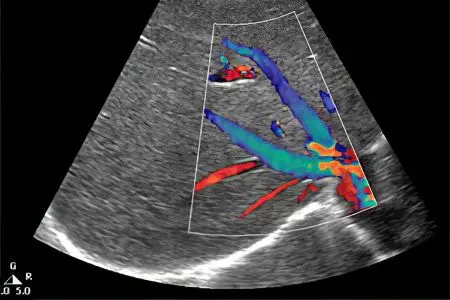Contents
Renal vein thrombosis is an occlusion (compression) of one or more veins penetrating the kidney. This pathology leads to the development of acute or chronic renal failure. Renal vein thrombosis is not an independent disease, but acts as a complication of many conditions. Some of them directly disrupt the blood flow in the organ, while others contribute to an increase in blood clotting.
Renal vein thrombosis is a rare phenomenon, it can develop both in an adult and in an infant. The lesion can be one- or two-sided.
Causes of renal vein thrombosis

Causes of renal vein thrombosis can be as follows:
The presence of a tumor in the kidney, which puts pressure on the vein.
Violation of blood clotting against the background of severe vomiting, diarrhea or excessive diuresis.
Nephrotic syndrome, which is accompanied by the loss of low molecular weight proteins by the body with urine. Renal vein thrombosis is observed, on average, in 35% of patients with nephrotic syndrome, regardless of what exactly caused it. Often, renal vein thrombosis develops in patients with membranous nephropathy (in 10-15% of cases). This condition contributes to the aggravation of proteinuria, but the obstruction of the renal vein itself rarely leads to the development of nephrotic syndrome.
Autoimmune diseases such as active systemic lupus erythematosus.
Proliferative glomerulonephritis, sickle cell nephropathy, renal vasculitis.
Long-term use of corticosteroid drugs in high doses.
Primary disorders of blood coagulation properties, for example, antithrombin 3 deficiency, prothrombin 620210A mutations, etc.
The development of thrombosis is possible when the body rejects the installed allograft.
The risk of developing pathology increases during pregnancy.
Rare causes of renal vein thrombosis include oral contraceptives, kidney injury, acute pancreatitis, and migratory thrombophlebitis.
It is impossible to exclude the “causeless” development of renal thrombosis in the postpartum period in a woman. Vein thrombosis in an implanted kidney is also known to medical science.
Symptoms of renal vein thrombosis
Most often, the onset of thrombosis goes unnoticed by the patient. Severe disturbances of well-being occur as the occlusion intensifies.
Symptoms in adults
Symptoms of renal vein thrombosis in adults:
Pain in the abdomen, which are localized on the sides, pain in the lower back. They can be so intense that they reach the level of renal colic.
Sometimes it is not pain that comes to the fore, but an increasing swelling of the lower extremities and external genital organs.
Nausea and vomiting.
Excretion of urine with blood.
Increased protein in the urine.
A sharp limitation in the amount of urine excreted.
Increase in blood levels of urea and creatinine to high values.
Kidney rupture or organ infarction is observed when the patient develops severe urinary stasis.
Increased blood pressure, which is accompanied by back pain.
An increase in body temperature, which is caused by the inflammatory process.
If young people most often experience a sharp development of the disease with a sudden onset and a gradual increase in symptoms of acute renal failure, then in older people the clinical picture is somewhat different. In them, thrombosis progresses slowly, and its only sign is often an increase in blood pressure. Alternatively, patients may experience recurrent pulmonary embolism. There are cases when renal vein thrombosis proceeded according to the type of Fanconi syndrome and according to the type of renal proximal acidosis.
Symptoms in babies
Symptoms of renal vein thrombosis in infants:
Severe pain in the abdomen.
Red coloration of urine due to the presence of blood in it.
The presence of protein in the urine.
A tumor-like formation may form in the lumbar region.
In children, the symptoms of acute renal failure increase much faster than in adult patients.
Diagnosis of renal vein thrombosis

Diagnosis of renal vein thrombosis is reduced to a thorough history taking. The patient must be sure to clarify whether his close relatives have thrombosis, it is important whether the patient smokes or not. The fact that a woman takes oral contraceptives also plays a role.
For a long time, angiography has been used to diagnose renal vein thrombosis, but modern treatment standards dictate different rules. In particular, we are talking about the use of multislice computed tomography. Moreover, it is best to give preference to tomography if renal vein thrombosis is suspected, since this procedure does not require the introduction of a contrast agent. The fact is that all contrasts have a greater or lesser nephrotoxic effect, that is, they negatively affect the state of the kidney. At a time when the body is already suffering from impaired functioning, diagnostic methods should be as gentle as possible.
Do not underestimate such a diagnostic method as ultrasound. Doppler ultrasonography can be used to detect renal vein thrombosis, but it is worth considering that the probability of obtaining a false negative result is high.
Be sure to conduct laboratory research methods that allow you to clarify the diagnosis. The doctor takes blood and urine from the patient for analysis. The doctor must conduct a differential diagnosis and distinguish between renal vein thrombosis and urolithiasis, which is especially important for young people.
Treatment of renal vein thrombosis
Operative methods of intervention for venous thrombosis are rarely used as the main methods of treatment. As a rule, a good effect can be achieved with the timely use of anticoagulants. Taking anticoagulants minimizes the risk of recurrent thrombosis of the renal veins, makes it possible to recanalize the lumen of the vessels, and improves the functioning of the kidneys. Treatment can be prescribed for a period of six months to a year. Provided that the patient has disorders in the blood coagulation system, then anticoagulant therapy will be prescribed for life.
If such a need arises, then thrombolytic drugs are injected directly into the renal vein, designed to destroy the formed clot.
After the main treatment has been carried out, antispasmodics, painkillers, drugs to lower blood pressure, drugs to improve blood supply to the kidneys and to normalize diuresis can be prescribed to normalize the patient’s condition.
Renal vein thrombectomy is performed only when the symptoms of acute renal failure rapidly increase, or there are contraindications to the administration of thrombolytics. Other indications for emergency surgery: bilateral renal vein thrombosis, complete kidney infarction, the presence of a tumor requiring removal.
Nephrectomy, that is, the complete removal of the organ, is performed only when a complete kidney infarction occurs, or the reason that led to vein thrombosis requires it.
In order to prevent recurrence of the disease and prevent thromboembolic complications, patients who have had renal vein thrombosis are shown to install a cava filter. It is injected into the suprarenal inferior vena cava.
Forecast
The prognosis for renal vein thrombosis is most often favorable. The probability of death of the patient remains extremely low, especially in the context of the provision of qualified medical care. A lethal outcome most often occurs due to a pulmonary embolism, a detached thrombus, or against the background of the development of severe complications in the form of nephrotic syndrome. Naturally, when making a prognosis, it is necessary to take into account the cause that led to the development of renal vein thrombosis. So, it will be the least favorable against the background of the presence of a malignant tumor in the patient.
Prevention
Prevention of renal vein thrombosis comes down to regular observation by a doctor about the underlying disease. This is especially true for people with nephrotic syndrome, as well as other risk factors for the development of pathology. Moreover, one of the features of thrombosis in nephrotic syndrome is its asymptomatic course, which does not reduce the risk of pathology.
[Video] Cardiovascular surgeon, phlebologist Abasov M. M. – Products that thin blood clots:









